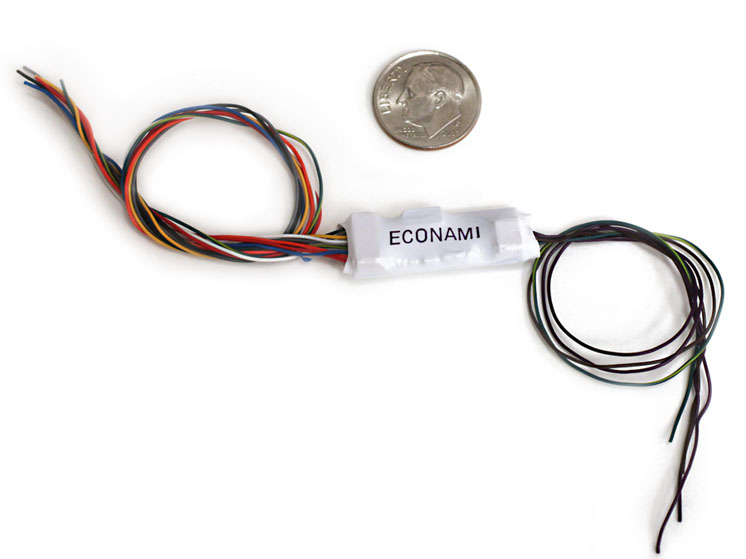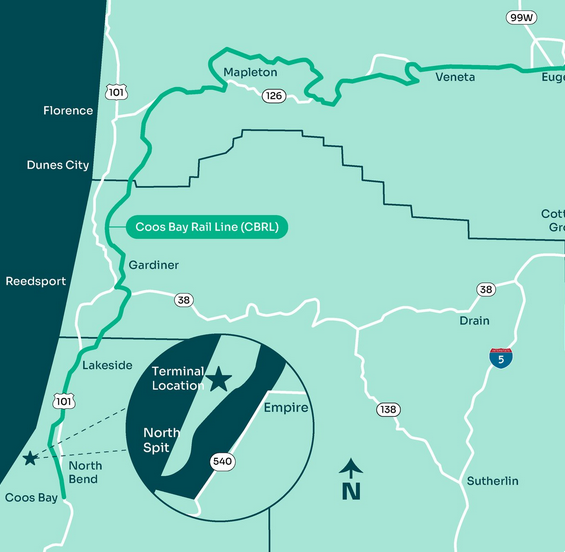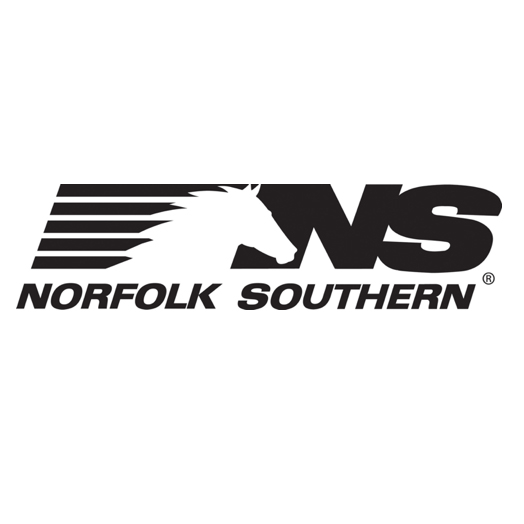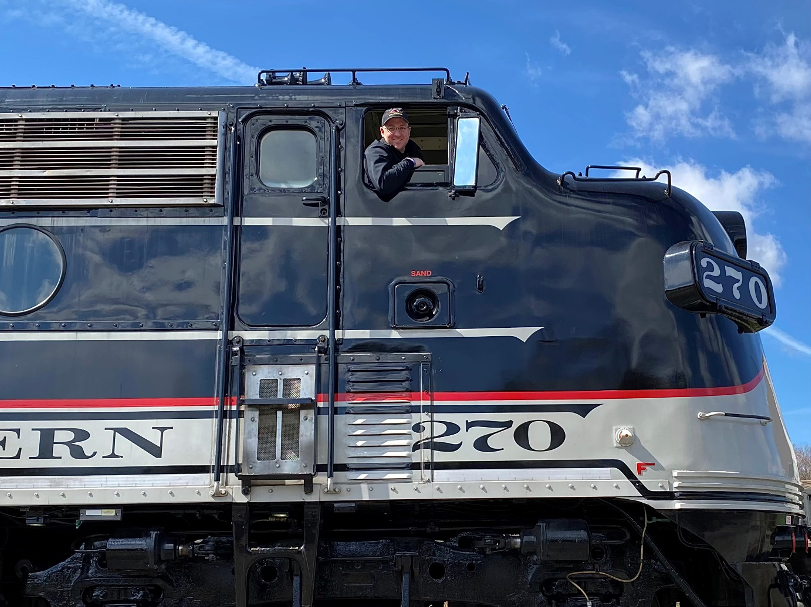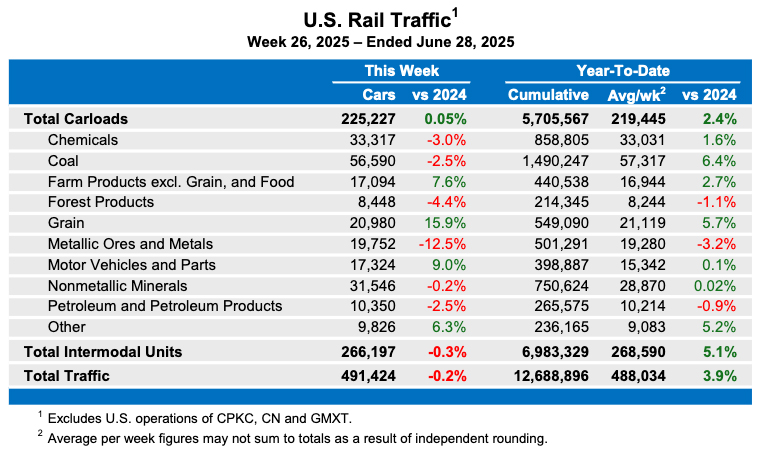Don’t mistake the new SoundTraxx Econami for a watered-down Tsunami. This new line of Digital Command Control (DCC) sound decoders features the same excellent sound quality and almost all of the features of the firm’s top-of-the-line Tsunami decoders. The Econami also boasts some all-new effects and more user-friendly programming.
Multiple options. Econami decoders are available in three formats. The ECO-100 measures only .197 x .413 x 1.063 inches (5 x 10.5 x 27mm). The decoder is narrower and only slightly longer than the SoundTraxx TSU-750 Micro-Tsunami, which measures 5.5 x 13 x 25.5mm. The ECO-21P measures .26 x .6 x 1.2 inches (6.5 x 15.5 x 30.5mm) and comes equipped with a 21-pin socket. The ECO-400 measures .56 x 1.2 x 2.7 inches (14 x 30.5 x 69mm) and is suitable for O and large scale applications.
Econami decoders are available in steam, diesel, or electric versions. Each version allows multiple options, making it possible to model the sounds of a variety of prototypes.
The steam version allows the user to choose between light, medium, heavy, and geared steam engine exhaust. The sound can be further modified to replicate simple or compound articulated steam engines.
The diesel version allows the user to choose between five common prime movers from Alco, Electro-Motive Division, and General Electric that represent first- and second-generation diesels, as well as the modern era’s most common engines. By programming CV123, a user can select between an Alco 244, EMD 567 (non-turbo), EMD 645 (turbo), EMD 710 (turbo), and the GE FDL-16 (modern).
The electric version contains options for modeling heavy electric as well as trolleys, including sound effects for pantograph extension and retraction.
All Econami decoders support the SoundTraxx CurrentKeeper. Sold separately for $24.95, this set of capacitors provides up to 10 seconds of power for uninterrupted operation and sound over dirty or uneven track. The CurrentKeeper must also be hard-wired to the ECO-100 decoder’s blue and green with yellow stripe wires. This component can be soldered to the board of the ECO-21P version, and its wires can simply plug into the appropriate socket on the ECO-400.
DCC performance. For this review I installed an ECO-100 steam version into a Trix HO scale United States Railway Administration light 2-8-2 that has an 8-pin DCC socket. Because the ECO-100 board is narrower than a 9-pin JST plug, there wasn’t a plug-in harness available. Instead, I soldered the decoder wires to an 8-pin plug. I then soldered the purple leads to a SoundTraxx 8Ω 28mm round speaker. [For information on the diesel version of this decoder, check out this month’s DCC Corner on page 74 of the January 2016 Model Railroader. – Ed.]
The Econami features the same excellent sound quality and programming options as the Tsunami, including a seven-band equalizer. Unlike the Tsunami, the decoder doesn’t include reverb control, but I didn’t miss it.
I easily programmed and ran the Econami-equipped locomotive with multiple DCC systems, including an NCE Powercab, Model Rectifier Corp. Prodigy Advance, CVP EasyDCC, and Java Model Railroad Interface DecoderPro using a SPROG DCC system. (The latest DecoderPro test version 4.1.2 supports Econami decoders (see jmri.sourceforge.net/ for more information).
The Econami provides excellent back-electromotive-force control, called Hyperdrive2. Without any extra programming, our steam version had the locomotive moving smoothly in speed step 1 at 2 scale mph. The locomotive also maintained this walking pace up a 3 percent grade.
When I quickly turned up the throttle, the decoder’s Digital Dynamic Exhaust increased the intensity of the chuffs. Unlike the Tsunami, the feature responds only to the throttle and not to the load placed on the motor. The absence of load-responsive DDE was made less of an issue for me by the new drift function. When the locomotive headed downgrade, I pressed function 5 to simulate the engineer moving the Johnson bar all the way forward and cutting the throttle. As on the prototype, the chuffs of working steam disappeared and the clanking of the side rods got louder.
I enjoyed the other new sound effects available on the steam decoder. These included the cylinder cocks on function 4, which are prototypically interrupted by the chuffs when the model gets underway, and a grade-crossing signal on function 9.
My favorite new feature is the Auto-Exhaust that automatically adjusts the chuffing sound with the operation of the motor. Although the synchronization would occasionally be off when the locomotive changed speed, the four chuffs usually matched the motion of the drivers after I fine-tuned the feature with configuration variable (CV) 114. The effect was more than close enough to my eye and ear, and better yet, I didn’t have to install a cam.
For many programming tasks, the decoder relies on indexed CVs, which expand the available programming options. The index CV must be first set to the proper value before entering the appropriate effect CV.
Indexed CVs are most useful in the Econami’s Flex-Map technology, which greatly simplifies function mapping. Unlike the Tsunami, with which certain functions can be mapped only to a limited range of keys, the Econami allows any function to be remapped to keys 0 to 28.
For example, I remapped function 11 (brake) to function 7. Like the Tsunami, the Econami also let me add actual brake functionality to the brake button. On the Econami, the “train brake” is activated using CV117.
Flex-Map technology also made it easier to set up automatic functions. I set up our 2-8-2 to automatically sound the appropriate whistle signal before moving forward (two toots) or backward (three toots) and when it came to a stop (one toot).
Extensive user and technical manuals specific to the Econami decoders are available at www.SoundTraxx.com.
DC operation. The Econami is dual-mode and operates similarly to the Tsunami on direct-current (DC) layouts. At 7V on our DC test track, I heard the sound of the air pump. As I continued to advance the throttle, the model moved smoothly, with the chuffs in synch with the drivers. Unfortunately the sounds cut out momentarily any time the direction switch was flipped. Triggering any other sounds requires an analog DC sound controller like the Model Rectifier Corp. Tech 6. This device also supports some CV programming, which is useful for setting the analog starting voltage and automatic sound effects.
Although its name implies a value-line product, the Econami is in many ways a new and improved SoundTraxx decoder. Better functionality and gold-standard sound make the Econami a natural choice for steam, diesel, or electric locomotives.
Price: $79.95 (ECO-100 and ECO-21P), $149.95 (ECO-400)
Manufacturer
SoundTraxx
210 Rock Point Drive
Durango, CO 81301
www.soundtraxx.com
Features
▪▪16-bit sound quality
▪▪DCC track voltage: 10V to 22V (ECO-100 and ECO-21P), 10V to 26V (ECO-400)
▪▪Four (ECO-100) or six (ECO-21P and ECO-400) 100mA lighting outputs
▪▪Maximum motor stall current: 1A (ECO-100 and ECO-21P), 4A (ECO-400)





